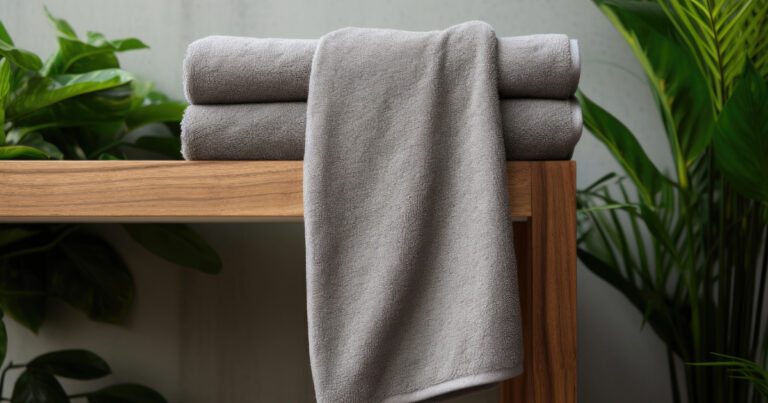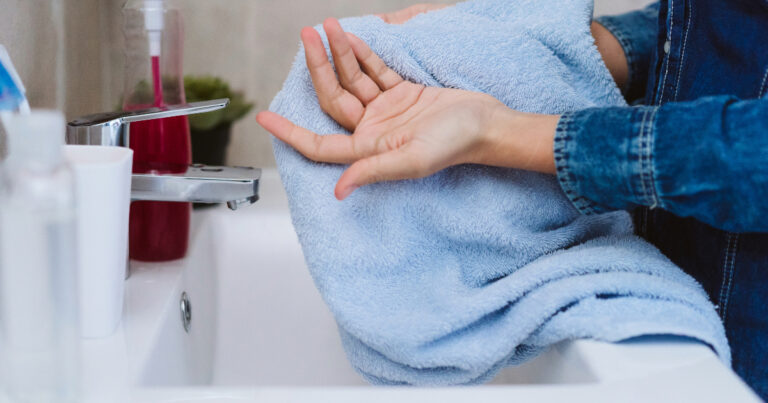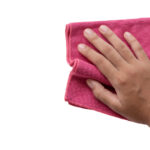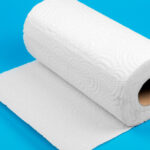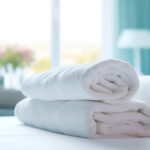Choosing the right bath towel is an important decision. After all, this is the linen you’ll use after every shower to dry your body.
A good bath towel should not only feel nice against your skin, but also effectively absorb moisture so you can get dry quickly.
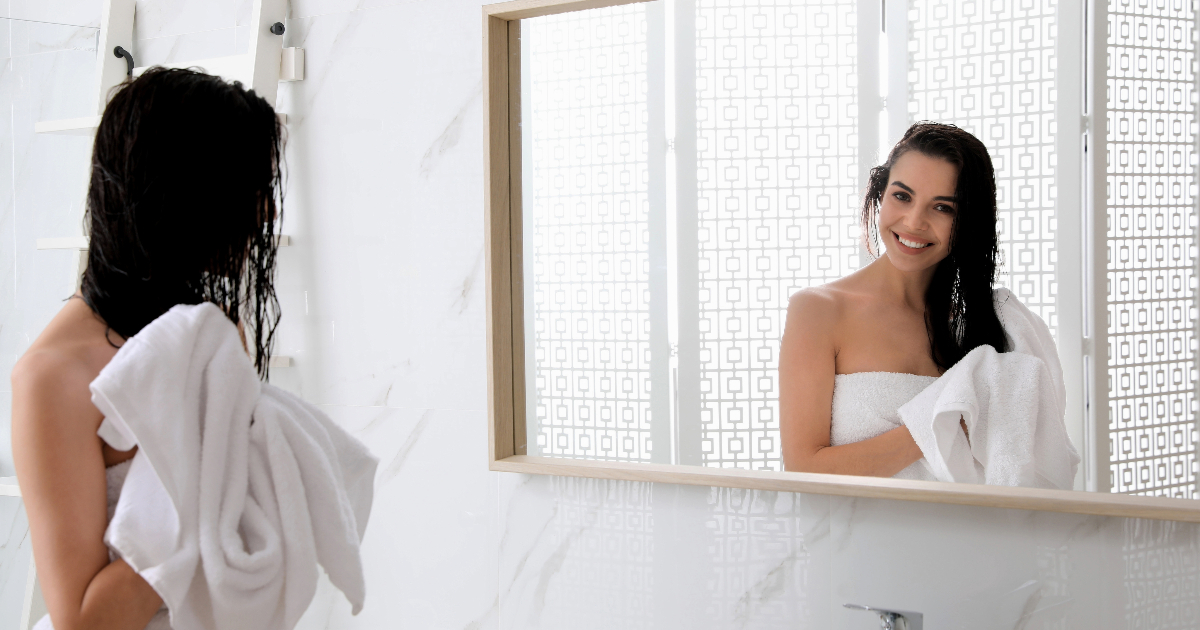
But with so many options on the market, how do you know which towel will absorb the most water?
Fabric Material Matters
The fabric that a bath towel is constructed from plays a major role in how much water it can soak up. Different materials have different absorbent properties:
- Cotton is the most popular towel fabric. The natural fibers form an absorbent structure perfect for pulling moisture away from the body. Egyptian or Turkish cotton towels made from extra long cotton fibers are especially soft and absorbent.
- Bamboo is naturally antibacterial and sustainable. However, bamboo rayon towels are generally less absorbent than cotton.
- Microfiber towels made from polyester and polyamides absorb water quickly. But they lack the plushness of cotton.
- Linen is very lightweight and dries fast. However, linen’s smooth fibers absorb less than cotton’s fluffy piles.
Density and Weight Matter
Towels come in a range of densities, measured in GSM or grams per square meter. This indicates the weight and thickness of the fabric.
- Lower GSM towels (300-400 GSM) are thinner and absorb less water overall.
- Medium-weight towels (400-600 GSM) offer a good balance of absorbency and drying time.
- Heavy, high GSM towels (600+) have a thick piled construction perfect for absorbing lots of water.
Construction Plays a Role
How the cotton fibers are prepared and woven together impacts the towel’s absorbency:
- Combed cotton with the shortest fibers removed creates durable, dense towels.
- Ring-spun cotton twists shorter and longer fibers together for soft yet absorbent yarns.
- Zero-twist cotton leaves loops un-twisted for maximum fluffiness and absorbency.
Absorbency Can Be Tested
It’s easy to test a towel’s absorbency before purchasing:
- Check reviews focused on how much water the towel holds.
- Look for videos and comparisons showing absorbency tests.
- Visit stores to wet part of a towel and see how quickly water soaks in.
- Consider factors like pile height and density as visual clues of absorbency.
Absorbency Varies by Towel Type
Not all bath towels are created equal when it comes to absorbency:
- Terry cloth towels have traditional woven piles excellent for absorbing water.
- Waffle weave towels absorb well but dry faster with their lattice texture.
- Ribbed towels utilize texture and channels to pull in water.
- Turkish towels are lightweight with high surface area for water absorption.
- Microfiber towels absorb well thanks to their fine synthetic fibers.
Absorbent Towels Require Proper Care
Caring for your absorbent towels will keep them performing their best:
- Wash towels in hot or warm water to remove residues that can impede absorbency.
- Avoid fabric softeners and dryer sheets, as they leave a coating that reduces absorption.
- Add white vinegar or baking soda periodically to strip away product buildup.
- Use an absorbency-safe detergent designed for cottons and linens.
- Replace heavily used towels annually as fibers break down over time.
Egyptian Cotton Offers Premium Absorbency
When it comes to cotton, not all varieties are created equal. Egyptian cotton is considered the top choice for both softness and absorbency:
- Grown in Egypt’s hot, dry climate, the cotton fibers are longer and smoother.
- Extra-long fibers create thin, strong yarns with a higher thread count.
- The soft, fine yarns craft an exceptionally absorbent pile.
- High-end Egyptian cotton towels can cost more but last for years.
Pima Cotton Absorbs Nearly As Well
Pima cotton is another excellent cotton variety for absorbent towels:
- Grown primarily in the American southwest, Peru, and Australia.
- Classified as extra-long staple cotton like Egyptian cotton.
- Fibers are nearly as long, soft, and smooth as Egyptian cotton.
- Crafts a flexible, breathable yarn that absorbs moisture well.
- More affordable than Egyptian cotton with comparable quality.
Absorbency Depends on Weight and Pile Height
For cotton terry towels, absorbency relies heavily on:
- Pile height – The denser and taller the cotton loops, the more water can permeate into the towel.
- Weight – Measured in GSM or grams per square meter, a higher weight equals a thicker, fluffier towel for absorbing more water.
For the most absorbency:
- Seek towels with a tall, tightly packed pile at least 1/4″ in height.
- Target heavier towels in the 600-900 GSM range.
- Balance plush pile height and heavier weight for optimal water absorption.
Absorbency Can Vary Within the Same Towel
It’s common for certain sections of a towel to absorb more water than others:
- Sections of pile that are washed, dried, and handled most will absorb better over time as fibers soften.
- Areas near edges or sides may absorb less depending on the border or edge construction.
- One side of the towel likely has slightly different absorbency than the other due to manufacturing processes.
- Sections of pile that are compressed, matted down, or ruffled can absorb less than fluffy areas.
Properly Laundering Boosts Absorbency
Absorbency can diminish over time as oils, residues, and minerals build up in the cotton fibers. Proper laundering helps restore a towel’s factory-fresh absorbency:
- Wash towels in the hottest water recommended on the label with an absorbency-boosting detergent.
- Avoid fabric softeners or dryer sheets that leave a coating that impedes moisture absorption.
- Add white vinegar, borax, or baking soda periodically to strip away residue buildup.
- Replace heavily used towels yearly as repeated washing gradually breaks down cotton fibers.
- Wash and dry new towels multiple times before first use to remove manufacturing coatings.
Thirsty New Towels Need Multiple Washes
Brand new bath towels require some extra washing attention before reaching peak water absorption powers:
- Manufacturers often add fabric conditioners, softeners, or light coatings during production for an appealing store feel.
- These extra finishes need to be washed away before the towel can achieve its maximum absorbency.
- Wash a new towel at least 3 to 5 times on the hottest setting before putting it into bath service.
- Add white vinegar during one wash cycle to help eliminate any leftover residue from manufacturing.
Shop Carefully Based on Intended Use
Factor your bathing needs into choosing the most absorbent towel:
- Frequent bathers or households with multiple users need a highly absorbent towel that can dry more than one person without getting too damp.
- Look for a 700+ GSM Turkish cotton towel.
- Those who like to dry off slowly may prefer a lighter bamboo towel that absorbs less.
- People who frequently wash their hair in the sink do well with a smaller but highly absorbent ribbed cotton hand towel.
Prioritize Absorbencyfor Babies and Children
Kids have sensitive skin, so choosing the right bath towel is important:
- Infant towels need soft fibers and maximum absorbency to gently dry delicate skin.
- Children’s towels should be plush and very absorbent to prevent any dampness against the skin.
- Seek extra-long-staple or organic cotton for softness and absorbency.
- Target a high 600+ GSM weight when choosing kids’ cotton towels.
- Consider smaller hooded or caped towel designs to provide extra comfort and warmth.
Combine a Super Absorbent Towel With a Fast Drying Towel
For families or roommates sharing a single bath towel, try this absorbent and fast drying towel combo:
- Use a super plush, high density cotton towel right out of the shower for maximum absorbency.
- Follow with a lightweight waffle weave or microfiber towel if needed to dry off fully.
- The absorbent towel pulls most of the moisture from your body.
- Then the thinner towel removes any remaining dampness quickly.
- This one-two absorbency punch reduces the need to launder towels as frequently.
Find the Best Absorbency for Your Budget
You don’t have to break the bank to find an absorbent bath towel. Many excellent budget-friendly options are available:
- Under $10 – Look for value packs of lightweight 100% cotton or microfiber towels. Absorbency and durability will be lower.
- $10-$25 – Well-made mid-weight cotton towels become available in this price range, providing good absorbency for the cost.
- $25-$40 – Increase absorbency noticeably in this price tier with Egyptian or Pima cotton towels boasting a plush 550+GSM weight.
- $40+ – Splurge for luxury 600+ GSM Turkish or extra-long-staple Egyptian cotton towels with hotel-level absorbency.
Prioritize Quality Over Quantity for Maximum Absorbency
It’s better to have fewer higher-quality absorbent towels than a huge stack of thin, subpar linens:
- Two ultra premium 500+ GSM Egyptian cotton bath and hand towels provide more absorbency than a set of 6 budget-friendly towels.
- Invest in the best absorbency your budget allows rather than purchasing lower priced, less effective towels in bulk.
- With proper laundering and care, premium absorbent towels last for many years.
- Use multiple lighter towels after bathing if needed rather than compromising on absorbency.
Top-Tier Absorbent Towels Are a Worthwhile Investment
Plush 600+ GSM cotton bath sheets or towels are an investment, with prices starting around $50 or more. But the benefits of true premium absorbency make them a sound long-term investment:
- Only one high-end absorbent towel needed instead of multiple lesser quality ones.
- Can be safely shared by multiple household members without getting overly damp.
- Less laundering needed since towels don’t get saturated as quickly.
- Sturdy construction and materials crafted to last for years with proper care.
- A high-quality item that makes a meaningful upgrade to your daily bath routine.
FAQs
What is the most absorbent towel material?
For bath towels, 100% cotton reigns supreme for absorbency thanks to its fluffy pile construction. Long staple Egyptian and Turkish cotton varieties excel at absorbing moisture.
Are older towels less absorbent?
Over time and repeated use, towels become less absorbent as oils and residue accumulate in the fibers. Regular deep cleaning or replacing heavily used towels after 1-2 years will maintain their moisture absorbing powers.
How do hotels get towels so absorbent?
Hotels utilize premium extra-long-staple cotton to craft highly absorbent towels. They also frequently replace old towels and launder new ones multiple times to maximize absorbency.
Do fabric softeners reduce absorbency?
Yes, liquid fabric softeners and dryer sheets leave a coating on fibers that inhibits moisture absorption. Use white vinegar in the wash instead to keep towels absorbent.
Should you wash new towels before first use?
Definitely, wash new bath towels at least 3 to 5 times to remove any manufacturing residue before putting them into bath service. This helps them achieve maximum absorbency.
Conclusion
Choosing the most absorbent bath towel comes down to picking the right combination of materials, construction techniques, and density.
For unbeatable water absorption, look for 100% cotton towels made from premium extra-long-staple Egyptian or Turkish cotton varieties.
Seek out a plush, heavy 600+ GSM weight featuring tightly packed zero-twist cotton piles at least 1/4″ tall.


